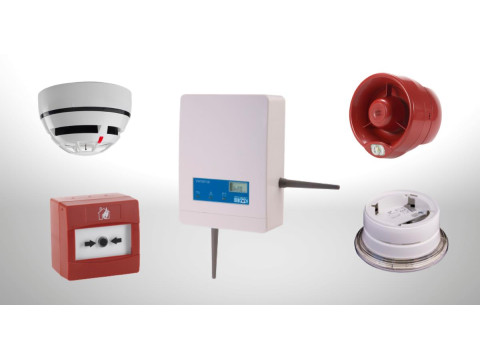WIRELESS FIRE ALARM SYSTEMS
Wireless fire alarm systems provide an innovative approach to fire safety, eliminating the need for extensive wiring while ensuring rapid detection and response. These systems are especially suited for spaces where traditional wiring is impractical, such as historic buildings, rented properties, or recently renovated spaces.
ADVANTAGES OF WIRELESS FIRE ALARM SYSTEMS
Quick Installation
- No need for cables simplifies the installation process.
- Ideal for spaces requiring minimal disruption, like operational businesses or rental properties.
Flexibility
- Easily installed in areas with architectural restrictions.
- Components can be reconfigured or expanded with minimal effort.
Precision and Reliability
- Each detector has a unique address, enabling precise location identification.
- No risk of wire damage disrupting system functionality.
Resilience to Interference
- Operates on frequencies less affected by low-frequency interference.
- Digital data transmission ensures signal accuracy.
LIMITATIONS
Battery Replacement
- Requires periodic battery changes, adding to maintenance responsibilities.
Interference Issues
- May face challenges in areas with thick walls or strong electromagnetic fields.
Higher Costs
- Initial equipment costs are higher than traditional systems but offset by reduced installation time.
REQUIREMENTS FOR WIRELESS SYSTEMS
According to GOST R 53325, wireless fire alarm systems must:
- Use unique component addresses for precise location tracking.
- Employ dual-frequency communication with backup channels.
- Include protocols ensuring secure and verified data exchange.
These systems must also withstand electromagnetic interference, providing a minimum of III or IV interference resistance grade, surpassing most wired systems.
MAINTENANCE OF WIRELESS FIRE ALARM SYSTEMS
Maintenance involves:
- Routine Inspections: Follow manufacturer guidelines for regular checks.
- Battery Management: Use standardized batteries to streamline replacements.
- System Diagnostics: Modern systems include built-in diagnostic tools and testing functions.
Advanced wireless systems allow for:
- Password-protected configuration changes.
- Remote testing of individual components.
- Data export for long-term performance analysis and archiving.
ECONOMIC AND FUNCTIONAL EFFICIENCY
Wireless fire alarm systems are cost-effective for spaces between 100 and 1,000 m². Their quick installation, flexibility, and ease of maintenance make them an excellent choice for modern safety requirements.
For top-tier wireless fire alarm systems, visit safsale.com—your trusted source for advanced fire safety solutions!

